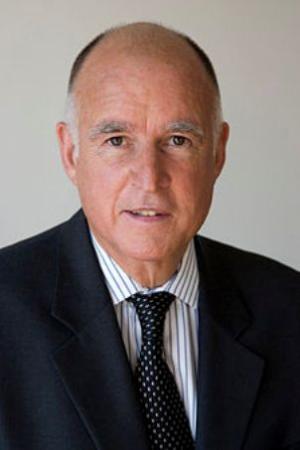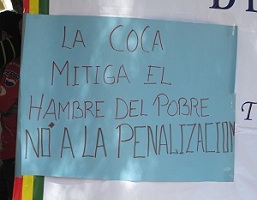Conservatives for sentencing reform? Who woulda thunk it? But that's what's happening.
State and federal courts have been grappling with the issue of whether police need a warrant to install a GPS tracking device on a vehicle. Now it may be headed for the Supreme Court.
Questions about marijuana legalization and drug policy dominated a YouTube "Ask Obama" forum last week, and this time, Obama responded with more than a laugh.
The next round of pot legalization initiatives is getting off the ground in the Pacific Northwest.
DrugWarFacts.org is an in-depth compilation of key facts, stats and quotes on the full range of drug policy issues, excerpted from expert publications. The Chronicle is running a series of info items from DrugWarFacts.org, and we encourage you to check it out.
Now, here's a shocker: An Illinois study finds that blacks are five times more likely to be sent to prison for drug possession than whites.
It was a relatively quiet week in Mexico's drug wars -- only a hundred people killed -- but Ciudad Juarez continues to live up to its reputation as one of the world's deadliest cities.
No cops got arrested this week for drug prohibition-related corruption, but a few got convicted, and one got sentenced.
Confronted with a new synthetic stimulant drug, a US senator reflexively reaches for the ban button.
As the US, UK, and Sweden file formal objections to Bolivian efforts to amend the UN 1961 Single Convention on Narcotic Drugs to end the proscription on coca leaf chewing, Bolivians take to the streets.
Iran is already one of the world's leading death penalty countries, but it has been hanging drug offenders at a record pace so far this year.
Events and quotes of note from this week's drug policy events of years past.
Struggling with chronic budget crises, lawmakers in more and more states are embracing sentencing and other reforms in a bid to hold down corrections costs. But while sentencing reform has long been the domain of "bleeding heart" liberals, now conservatives are driving those efforts in some states.

Indiana's Republican Gov. Mitch Daniels wants sentencing reforms...(Image via Wikipedia)
It's not just about dollars. Although fiscal concerns are a driving force among conservatives, there are also signs they are recognizing and confronting the failures of our drug and criminal justice policies. In a recent
Washington Post op-ed, none other than former House Speaker Newt Gingrich wrote of "more humane, effective alternatives" to the national imprisonment binge.
Still, as their states bleed red ink, some of them are shifting from "tough on crime" to "smart on crime." Leading the charge is a newly formed advocacy group,
Right On Crime, endorsed by big conservative names including Gingrich, taxpayer advocate Grover Norquist, and former drug czar William Bennett.
Based in Texas, Right On Crime is touting the success the Lone Star State has had with sentencing reform to make such reforms more palatable to conservatives. In 2003, the state passed legislation ordering that small-time drug offenders be given probation instead of prison time, and in 2007, the state rejected prison-building in favor of spending $241 million on treatment programs for offenders.
Crime rates declined at the same time the incarceration rate did. And the state has saved about $2 billion by not building an additional 17,000 prison beds it once thought it needed.
Now, conservatives in other states are pushing similar reforms -- Right on Crime identifies
21 states it says are engaged in "conservative" sentencing and corrections reforms.
"The fiscal argument is resonating with conservatives and liberals alike these days," said Marc Mauer, executive director of the
Sentencing Project. "Prison and corrections spending is the big elephant in the room right now; it is ripe for cuts."
But it's not just the fiscal argument, said Mauer. "Some of this is in keeping with conservative philosophy, and much of their concern about incarceration has focused on drug policy. The drug war encompasses the whole country, but the federal system is an enormous part of it. Conservatives view it as taking over areas of policy that should best be left to the states," he said. "And then there are sort of libertarian conservatives who don't think the government should be telling us what is appropriate behavior."
It is also the result of years of effort by key advocates, said Mauer. "People like Pat Nolan at the
Justice Fellowship have been working with that community for over a decade now about why this should be a conservative issue also," he pointed out.
Mauer welcomed the emergence of conservatives interested in sentencing reform. "We need to broaden the range of voices that are being heard on these issues," he said. "They can be helpful in a couple of ways, most importantly in communicating that these are not necessarily liberal or conservative issues, but good public policy perspectives. It's kind of ironic that the one area where there seems to be real bipartisan cooperation happening is in criminal justice policy."
"I think it's a good thing," said Traci Velasquez, executive director of the
Justice Policy Institute (JPI). "The work that JPI and a lot of others have done over the years points out financial and social reasons why existing drug and other criminal justice policies have been ineffective, and some of those reasons are conservative: It doesn't work and it costs too much. I'm glad to see voices across the political spectrum are speaking out on this."
The years of laying the groundwork are starting to pay off now, said Velasquez, who also pointed to the efforts of the Justice Fellowship. "There has been a lot of receptivity this year," she said. "When governors gave their inaugural speeches this year, I think there were ten of them that included things about criminal justice reform, locking up fewer people, and helping ex-prisoners be more successful in the community."
Sentencing and other criminal justice reforms are also benefiting from a sort of benign neglect, Velasquez said. "Because the media is focused on a lot of other issues, there is a little more space to talk about these issues," she said. "Between the Middle East, the overall economic crisis, and two wars, the media doesn't have a lot of time to push a hysterical criminal justice narrative as it did in the past. Now, policymakers can worry less about commentators ripping them apart as soft on crime."
Whether or not conservatives actually accomplish sentencing reform, the fact that they are now addressing it is a positive step, said Mauer. "If nothing else, just the symbolism of these leading conservatives coming out helps shift the political climate under which these issues are being addressed," he said. "It makes it a little more comfortable to talk about it."
The fact that the states are now collectively spending $50 billion a year on corrections, making it their second-fastest growing spending category behind Medicaid, according to the
Pew Center on the States, is impelling efforts at change in places not previously known as bastions of reform:
In
Indiana, Republican Gov. Mitch Daniels has made a massive criminal justice system overhaul one of his top legislative priorities this year. Based on a
report from the bipartisan Indiana Criminal Code Evaluation Commission, the package includes recommendations to cut sentences for possession and sale of cocaine and methamphetamine.
In the past decade, even though crime rates fell in Indiana, the prison population increased by 40%. Corrections spending also increased, although not as much, and now swallows up $616 million a year. More than half of Indiana prisoners are drug or property offenders. If current trends continue unabated, the report found, the prison population will increase by another 21% by 2017, and the state will have to spend an additional $1.2 billion on top of current corrections spending just to make room to house them.
While the reforms have broad support, not everybody is on board. The Association of Indiana Prosecuting Attorney has voted to oppose the recommendation to cut drug sentences.
"There are all kinds of proposals on the table that reduce and reassign sentencing levels," the group's 2010 president, Shelby County Prosecutor Kent Apsley told the
Indianapolis Star last month. "Some of them in my view are pretty extreme changes in the law and probably go too far. The question is: Where is the breaking point where you're saving money to the point that it may seriously impact public safety?"
In Pennsylvania, Democratic state Auditor General Jack Wagner last week endorsed Republican Senate Judiciary Committee Chairman Stewart Greenleaf's SB 100, the Criminal Justice Reform Act, which seeks to reduce corrections costs by allowing the state to more quickly transfer nonviolent offenders to community corrections centers and allowing more nonviolent offenders to be eligible for the community centers.
"With Pennsylvania facing its greatest budget crisis since the Great Depression, we must look for sustainable savings in every nook and cranny of state government, and that includes the criminal justice system, which is one of the three biggest drivers of increased spending over the past decade," Wagner said.
Pennsylvania's prison population has increased five-fold since 1980, to more than 51,000 last year, and was the fastest growing in the country last year. According to Wagner, that increase is "due in part to tougher sentencing guidelines, particularly with drug-related offenses."
The alternative sentencing proposals in SB 100 could save the state $50 million in the coming fiscal year and $350 million over the next four years, Wagner said in a statement as he released a report on corrections spending whose recommendations largely dove-tailed with the bill. But the title of the statement, Auditor General Jack Wagner Says PA Needs Sentencing Reform, Construction Freeze to Shrink Corrections Cost, pretty well summed it up.
The state is already committed to spending $860 million to build four new prisons and four new housing units to hold another 9,000 inmates, but those will be full as soon as they are built. Wagner is saying no more prison-building.
"While most economic sectors in the commonwealth remain mired in recession, prisons remain Pennsylvania's largest growth industry," he said.
Serious conservative reform efforts are also underway in Kentucky and Louisiana, among others, but while conservative support for sentencing reforms is making waves, liberals are not shirking, either. Reform measures are afoot in a number of states. Here are two examples:

...and so does California's Democratic Gov. Jerry Brown (Image via Wikipedia)
In
California, Gov. Jerry Brown (D) last month outlined plans to save half a billion dollars a year by keeping "nonviolent, non-serious, non-sex offense" first-time offenders out of state prison. Those convicts would instead be housed in county jails. It is not sentencing reform, but it will take some of the pressure off the state prison system.
Drug offenders are among those who could be affected. Currently, there are some 10,000 people serving time in California for drug possession, as well as several thousand serving time for marijuana manufacture or distribution offenses.
The measure has the support of the
Drug Policy Alliance (DPA), which also called for a greater investment in drug treatment. "Governor Brown set an important tone and made it clear that our expensive state prisons should be reserved for people convicted of serious offenses, not for everyone who's ever made a mistake," said Margaret Dooley-Sammuli, DPA deputy state director for Southern California. "California is expected to save $500 million a year by handling more petty offenses, including low-level drug possession, at the county level. We think the savings would be even greater if drug treatment were made more available in the community. Under the plan, counties would have that option."
In
Massachusetts, Democratic Gov. Deval Patrick is calling for the repeal of many of the state's mandatory minimum sentences for drug offenses as part of a
criminal justice reform package he unveiled last month. Patrick's proposal would also allow nonviolent drug offenders to become eligible for parole, work release, and earned "good time" credits, and it would reduce the size of school "drug-free" zones from 1,000 feet to 100 feet.
The governor's proposal was "a bold move," but also "just basic common sense," said Barbara Dougan of
Families Against Mandatory Minimums (FAMM). "The governor’s bill would simply realign our current drug sentencing policies so that they are in sync with what we know about who is being sentenced to mandatory prison terms and what those people need to stay out of trouble when they leave prison," she continued. "Nearly two-thirds of those sentenced to mandatory prison terms fall into the two lowest level 'criminal history' groups -- no prior record or few lower level offenses. Yet too often they serve disproportionately harsh sentences, sometimes longer than those who commit violent crimes. As a result, the public pays for lengthier sentences than are warranted."
But, as in Indiana, prosecutors and law enforcement officials are coming out in opposition to at least part of the proposal. According to the
Boston Globe, they are objecting to shrinking the school "drug-free" zone because doing so "would allow dealers to sell drugs very close to schools and would weaken strong drug laws passed during the 1980s crack cocaine scourge."
Conservatives are now joining liberals in trying to bring some common sense and fiscal sanity to the nation's drug and sentencing policies. But as police and prosecutor organizations have shown, reform threatens some powerful groups' turfs -- one man's cost is another's benefit. The sentencing reform battle is far from won, but the battle is joined, and we have reinforcements.
back to top

GPS satellite
by Clarence Walker
[Editor’s note: This feature story is part two of an occasional series involving electronic surveillance and its impact on the Fourth Amendment in drug investigations and other criminal matters in the United States. Read the first installment in the series here. Clarence Walker is a Houston-based criminal justice journalist. He can be reached at [email protected].]
Recent federal and state court decisions that overturned narcotic convictions of suspected drug dealers as a result of law enforcement using warrantless GPS tracking devices to watch suspects have triggered an intense debate over the Fourth Amendment, which provides citizens against unreasonable search and seizures.
The GPS controversy is at the center of a raging legal discussion over privacy rights: Should law enforcement be allowed to install a GPS on a vehicle without a warrant during criminal investigations to track a suspect’s movement 24-7, and does warrantless tracking violate a person’s privacy although they are being watched by the police in public?
Two significant 2010 decisions on privacy rights under the Fourth Amendment highlight the continuing struggles that courts around the country are having around GPS tracking. In August, the DC 9th Circuit Court overturned the conviction of Antoine Jones based on police using a warrantless GPS to connect Jones to places containing several kilos of cocaine. Jones was sentenced to life without parole at Supermax federal prison in Florence Colorado. (Read more about the Antoine Jones case
here.)
Legal experts say this case might go before the US Supreme Court. Federal prosecutors were denied an en-banc hearing in November to have a full court to throw out the 9
th Circuit decision, and they have until February 14 to petition the Supreme Court to consider their appeal of the Jones case. In the meantime, Jones continues to sit in prison.
"When the court denied the government an en-banc hearing, this sets up the Antoine Jones case for the Supreme Court to decide if GPS tracking violates the Fourth Amendment. The importance of the Jones case is that it would be the first time the Supreme Court would decide GPS surveillance in relation to search and seizure," said Stephen Lecklar, who wrote the appeal that reversed Jones conviction.
In a second case,
Delaware v. Holden, on December 28, Delaware Superior Court Judge Jan Jurden reversed a suppression hearing from a lower court involving drug charges against Michael Holden. Holden, a Newark resident, was stopped by police carrying 10 pounds of marijuana. The evidence showed that prior to arresting Holden, police used GPS tracking without a warrant to follow him for 20 days.

Antoine Jones remains in federal prison pending, he hopes, one last government appeal. (Image courtesy the author)
According to
press accounts, Deputy Attorney General Brian Robertson argued that information from the GPS that police attached to Holden’s vehicle was only a part of a larger "multifaceted case" against the marijuana trafficker. But Holden’s attorney, John Decker, told the court that "the 20-day long use of the GPS amounted to an unreasonable search under the state constitution and violated his client's privacy without probable cause."
"The advance of technology will continue ad infinitum," said Judge Jurden in throwing out the charge. "An Orwellian state is now technologically feasible. Without adequate judicial preservation of privacy, there’s nothing to protect our citizens from being tracked 24-7. And if no warrant is required for such surveillance any individual could be tracked indefinitely without suspicion of any crime by police without probable cause."
Meanwhile, Antoine Jones remains frustrated over the fact of being unable to be released on bond although his conviction has been reversed and the appellate courts this past November also denied the feds to an en-banc hearing to strike down the ninth circuit original decision.
"We are pleased that the Court of Appeals declined the Government's request for en banc reconsideration and reaffirmed the constitutional concerns identified by the ninth circuit," Jones' appellate attorney, Stephen Leckar, said in an email sent to reporters covering the case.
But Jones questions why he's still in prison."My conviction has been overturned, the en-banc hearing was denied, the appeal process is over but I am still in this hellhole," he wrote to the author. "The feds' last shot is to petition the US Supreme Court, but the experts have said that only one-percent of petitioners are chosen for review."
"The court should release Mr. Jones on bond," said California attorney Diane Bass, who handles federal drug cases.
Chances for Jones's release on bond pending the government's next course of action are unclear. "The issues that a court looks at when deciding whether to release someone on bond are, is the defendant a flight risk or a danger to society," Bass said. "In an appeal situation, they also look at whether there are viable issues on appeal. Drug cases carry a presumption of flight, because of the mandatory minimum sentences which the defendant has the burden of rebutting. And the court would require an equity of $100,000 or more. I would say that since there's a possibility the Supreme Court will deny certiorari in this case, the court would be wise to release Mr. Jones on appeal."

Delaware Superior Court Judge Jan Jurden
While Jones sits in federal prison pending the resolution of his case, the thorny issue of warrantless GPS tracking and the Fourth Amendment continues to vex the courts. When the issue finally arrives at the Supreme Court, it will have to decide first whether GPS tracking constitutes a "search" under the Fourth Amendment, and second whether long-term, continuous GPS tracking without a warrant amounts to an illegal search.
"There's no clear Supreme Court guidance on this issue," said John Verdi, a senior counsel at the Electronic Privacy Information Center, a DC-based advocacy group. "Courts have left the states to decide what should be done using their own state constitutions."
Some states, like Texas, have specific requirements law enforcement officers must meet to obtain a warrant for GPS tracking. What isn't too well publicized is that an officer can ask the court for a tracking order based on reasonable suspicion as opposed to requesting a warrant which require a higher burden of probable cause.
Steve Baldassano, a senior-level prosecutor with the Harris County District Attorney Office in Houston explained: "A tracking order requires 'reasonable suspicion.' If it's okay for a cop to follow someone in a car, it's not that much worse if the cops watch a person using electronic signals."
An unidentified Houston Police Department narcotic officer offered this blunt view: "Theoretically, a person can have a GPS tracker placed on their vehicle for life as long as the investigator has reason to believe the person will commit criminal offenses."
Whatever the realities on the street, the state and federal courts have split on warrantless GPS tracking and related issues. Courts in Wisconsin and Virginia have supported warrantless tracking, while courts in New Jersey, New York, Oregon, and Washington have ruled against it. With the federal appeals court also split, the issue seem ripe for Supreme Court review.
In the meantime, big brother is staying busy. Maryland state officials announced last year they would implement a statewide network in 2011 to collect data from automatic license plate readers. "The license plate reader provides the plate number, exact time, and the GPS location of a vehicle upon sight," the Muckraker blog noted.
With technological innovation fueling the rise of the surveillance state, preserving one's privacy from the state looks to be ever more difficult. By the time the Supreme Court has sorted out warrantless GPS tracking, there will doubtless be some new form of surveillance that we will have to be litigated.
back to top
That would require "shifting resources and being strategic," he said, citing lengthy waits for drug treatment. "We also have to look at what we're doing with nonviolent first-time drug offenders," suggesting that drug courts could be an answer. "These are all issues worth exploring," he said.
Legalization and related issues made more than a respectable showing in the lead-up to Thursday's YouTube "Ask Obama" forum -- of the top 200 most popular questions submitted, nearly all were on drug policy. The legalization question followed other questions submitted about jobs and the economy, education, a series of "personal questions" ("What's the best and worst thing about being president?" "Who will win the Superbowl?"), the role of social media in the ongoing Middle East unrest, US policy in Iraq and Afghanistan, and energy policy.
"The president talks a good game about shifting resources and having a balanced, public health-oriented approach, but it doesn't square with the budgets he's submitted to Congress," responded LEAP executive director Neill Franklin, a retired Baltimore narcotics cop. "The Obama administration has maintained the Bush-era two-to-one budget ratio in favor of prisons and prosecution over treatment and prevention. It doesn't add up. Still, it's historic that the president of the United States is finally saying that legalizing and regulating drugs is a topic worthy of discussion. But since the president remains opposed to legalization, it's clear that the people are going to have to lead the way. Police officers and innocent civilians are dying every single day in this drug war; it's not a back-burner issue."
Following his 2011 State of the Union address, President Obama asked the public to submit questions for an exclusive YouTube Interview that took place Thursday. The "Ask Obama" forum promised to take questions from the American people on the issues they find most important in terms of national policy.
back to top
Marijuana law reform activists in the Pacific Northwest are moving ahead with renewed efforts to win legalization at the ballot box. In the last few days, legalization initiatives have been filed with state authorities in Oregon and Washington.

marijuana-plants_0_6.jpg
In both states, similar legalization initiatives failed to make the ballot last year. This time around, organizers in both states say they are better prepared for the arduous and expensive process of signature-gathering to make the ballot.
In Washington,
Sensible Washington, the folks behind last year's failed effort, have filed an
initiative that removes all criminal penalties for adults who use, possess, produce, transport, or distribute marijuana. Unlike last year's initiative, which lost critical support for its failure to address regulation of the marijuana market, this year's version explicitly directs the state legislature to enact a regulatory scheme.
Sensible Washington is aiming for this year's November election ballot, despite pleas from some national and state reform figures to hold off until the presidential election year in 2012.
"We're pleased to again put the important question of marijuana legalization before the public," said Seattle attorney Douglas Hiatt, Sensible Washington’s chair and initiative coauthor. "We’re better funded and better organized this year and we look forward to giving the public an opportunity to vote on this issue in November. We've changed last year’s initiative to reflect concerns about civil regulations of marijuana, and our new initiative has language that clearly directs the state legislature to regulate the responsible adult use of marijuana."
The group expects to start signature-gathering this month. They need 241,153 valid voter signatures to make the November ballot.
In Oregon, the
Oregon Cannabis Tax Act (OCTA 2012) initiative is back. Organizers turned in 2,200 signatures on January 4 to start the ballot title creation process. The initiative has until July 2012 to turn in nearly 86,000 valid voter signatures to make the November 2012 ballot. In an email to supporters, D. Paul Stanford of the
Campaign for the Restoration and Regulation of Hemp vowed to gather at least 130,000 signatures to ensure a comfortable cushion. The initiative is also supported by
Oregon NORML.
OCTA 2012 would allow Oregonians 21 or over to possess and grow marijuana. It would also create an Oregon Cannabis Commission to oversee the regulation of commercial cultivation and distribution. The commission would sell marijuana through its own outlets, similar to state liquor stores.
And so the next round begins.
back to top
DrugWarFacts.org, a publication of Common Sense for Drug Policy (CSDP), is an in-depth compilation of key facts, stats and quotes on the full range of drug policy issues, excerpted from expert publications on the subjects. The Chronicle is running a series of info items from DrugWarFacts.org, and we encourage you to check it out.
Did you know that African Americans are ten times more likely to be incarcerated for drug offenses, despite drug use rates between blacks and whites being roughly similar?
"The racial disparities in the rates of drug arrests culminate in dramatic racial disproportions among incarcerated drug offenders. At least two-thirds of drug arrests result in a criminal conviction. Many convicted drug offenders are sentenced to incarceration: an estimated 67 percent of convicted felony drug defendants are sentenced to jail or prison. The likelihood of incarceration increases if the defendant has a prior conviction. Since blacks are more likely to be arrested than whites on drug charges, they are more likely to acquire the convictions that ultimately lead to higher rates of incarceration. Although the data in this backgrounder indicate that blacks represent about one-third of drug arrests, they constitute 46 percent of persons convicted of drug felonies in state courts. Among black defendants convicted of drug offenses, 71 percent received sentences to incarceration in contrast to 63 percent of convicted white drug offenders. Human Rights Watch’s analysis of prison admission data for 2003 revealed that relative to population, blacks are 10.1 times more likely than whites to be sent to prison for drug offenses."
Source: Fellner, Jamie, "Decades of Disparity: Drug Arrests and Race in the United States," Human Rights Watch (New York, NY: March 2009), p. 16, http://www.hrw.org/sites/default/files/reports/us0309web_1.pdf (via the DrugWarFacts.org Race and Prison chapter).
"Current illicit drug use among persons aged 12 or older varied by race/ethnicity in 2008, with the lowest rate among Asians (3.6 percent) (Figure 2.9). Rates were 14.7 percent for persons reporting two or more races, 10.1 percent for blacks, 9.5 percent for American Indians or Alaska Natives, 8.2 percent for whites, 7.3 percent of Native Hawaiians or Other Pacific Islanders, and 6.2 percent for Hispanics."
Source: Substance Abuse and Mental Health Services Administration. (2009). Results from the 2008 National Survey on Drug Use and Health: National Findings (Office of Applied Studies, NSDUH Series H-36, HHS Publication No. SMA 09-4434). Rockville, MD, p. 25, http://www.oas.samhsa.gov/nsduh/2k8nsduh/2k8Results.pdf (via the DrugWarFacts.org Race and Prison chapter).
Follow Drug War Chronicle for more important facts from DrugWarFacts.org over the next few weeks, or sign up for the DWF new facts RSS feed. To see last week's DWF Drug War Chronicle blurb, click here.
Common Sense for Drug Policy is a nonprofit 501(c)(3) organization dedicated to reforming drug policy and expanding harm reduction. CSDP disseminates factual information and comments on existing laws, policies and practices.

back to top
An Illinois state panel found Monday that Illinois blacks convicted of low-level drug possession offenses are much more likely to be sentenced to prison than whites. According to the Illinois Disproportionate Justice Impact Study Commission, 19% convicted of drug possession were imprisoned, while only 4% of whites were.

Joliet Prison (image via Wikimedia)
The disparity was even worse in the state's most populous jurisdiction, Cook County. While statewide, blacks were five times more likely to be imprisoned for drug possession than whites, in Cook County, the figure was eight times.
The commission was formed in 2009 to examine incarceration rates between the races. Legislation to create it was sponsored in the state Senate by Sen. Mattie Hunter (D-Chicago), who co-chairs the panel.
"It's always disappointing to know the true facts," Hunter said in remarks reported by the
Chicago Sun-Times.
The sentencing disparity comes despite research that shows that blacks and whites nationally use illegal drugs at roughly the same rate, said Pamela Rodriguez, president of
Treatment Alternatives for Safe Communities, a Chicago-based nonprofit that led the commission’s research. She cited a 2008 federal study that 10.1% of blacks and 8.2% of whites reported using illegal drugs.
Rodriguez said the disparity could be partially explained by differences in education and economic status, but that blacks were also more likely to conduct drug transactions in public spaces, where they are easily targeted by police. "Where you have greater enforcement, you have greater arrests," Rodriguez said. "Where you have greater arrests, you have greater prosecutions."
The commission called for funding alternatives to imprisonment as a way to reduce the disparity. The state has programs in place, including drug courts and first-time offender probation, but it needs new revenue to fund them adequately.
Sen. Hunter suggested that the commission would look at using part of local jurisdictions' drug forfeiture funds to pay for alternatives to imprisonment. That would be preferable to leaving them in the hands of police forces, which use them to arrest more drug offenders and seize more funds to arrest more drug offenders and seize more funds in a vicious cycle of drug law enforcement.
back to top
by Bernd Debusmann, Jr.
Mexican drug trafficking organizations make billions each year smuggling drugs into the United States, profiting enormously from the prohibitionist drug policies of the US government. Since Mexican president Felipe Calderon took office in December 2006 and called the armed forces into the fight against the so-called cartels, prohibition-related violence has killed more than 35,000 people, including more than 15,000 last year. The increasing militarization of the drug war and the arrest of dozens of high-profile drug traffickers have failed to stem the flow of drugs -- or the violence -- whatsoever. The Merida initiative, which provides $1.4 billion over three years for the US to assist the Mexican government with training, equipment and intelligence, has so far failed to make a difference. Here are a few of the latest developments in Mexico's drug war:

Black market profits fuel deadly violence. Who could ever have predicted that? (Image via Wikimedia)
In Tamaulipas,
an American missionary was shot and killed when gunmen opened fire on her truck at an illegal roadblock. Nancy Davis, 59, had been involved in missionary work in Mexico for the last 30 years. Tamaulipas is a stronghold of drug trafficking organizations in Mexico and has seen drastic increases in violence over the last year as the Zetas Organization battles its former masters, the Gulf Cartel.
Friday, January 28
In Ciudad Juarez,
two federal police officers were charged with killing one of Ciudad Juarez’s mayor's bodyguards during an incident the previous week.
In Veracruz,
33 ex-mayors have been ordered arrested on corruption charges.
In Pantanal, Nayarit,
four men were killed during a firefight between two rival gangs. The gunmen were heavily armed with assault rifles and grenade launchers. The incident took place after one group of gunmen attacked a safe house used by another group. Pantanal is located in the municipality of Xalisco, which is well known as a hub for traffickers who export black tar heroin to the United States.
Saturday, January 29
In Monterrey
, five gunmen were killed after attacking an army convoy in the suburb of Santa Catarina. Two innocent bystanders were wounded by grenades during the gun battle.
Near Acapulco,
a mutilated body was discovered hanging from an overpass bridge was spans the busy Acapulco-Mexico City highway. The unidentified victim had been severely beaten and tortured.
Monday, January 31
In Mexico City,
prosecutors announced a $658,000 reward for information leading to the arrest of two suspects in the massacre of 72 migrants last August. The two men are known as "The Coyote" and "The Scorpion" and are thought to be members of the Zetas Organization. Eight other Zetas suspected of taking part in the massacre are already in custody.
In Ciudad Juarez,
at least 11 people were murdered in different parts of the city. Among the dead was a 16-year old girl who succumbed to her wounds after being shot by federal police alongside her 13-year old sister, who was wounded. According to a tally by local newspaper El Diario, 216 people were murdered in Ciudad Juarez in the first month of 2011. Last year the city had 3,111 murders take place.
Wednesday, February 2
In Guadalajara,
suspected cartel gunmen used grenades, burned vehicles and created makeshift blockades in a series of seven incidents across the city. A policeman and two transportation workers were wounded. The attacks seem to be in retaliation for the recent arrest of drug gang members.
In Monterrey, a federal police officer and three gunmen were killed during an attack on an army convoy in the suburb of Apodaca. Three policemen were wounded and an unknown number of suspects were taken into custody. In a separate incident in Monterrey, three other gunmen were killed by federal police personnel.
Total Body Count for the Week: 103
Total Body Count for the Year: 641
Total Body Count for 2010: 15,273
Total Body Count for 2009: 9,600
Total Body Count for 2008 (approx.): 5,400
Total Body Count for 2007 (approx): 4,300
Total Body Count for Calderon’s drug war through 2010: 34,612
Total Body Count for Calderon’s drug war to date: 35,253
back to top
No cops got arrested this week for drug prohibition-related corruption, but a few got convicted, and one got sentenced. Let's get to it:
In Jacksonville, Florida, a Jacksonville Sheriff's officer was convicted Friday of filing a false police report about a burglary to illegally enter a suspected drug house without a search warrant. Officer Marc Garza, a gung-ho narcotics officer, was convicted of official misconduct and falsifying an official document. He faces up to six years in prison. He also faces another criminal trial, this one for beating a handcuffed drug defendant.
In Kerrville, Texas, a former Texas state trooper pleaded guilty Monday to peddling steroids. Jeff Jerman copped to three counts of delivery of a controlled substance after admitting he sold $800 worth of steroids to an undercover police officer in 2009. He's looking at up to two years in state jail and a $10,000 fine when sentenced March 11.
In New York City, an NYPD detective was convicted Monday of conspiracy for paying off snitches with drugs. Det. Sean Johnstone, 37, was part of a Brooklyn dope squad rife with corruption, with the narcs taking cash, drugs, and sex from criminals and drug users. Despite being caught on tape bragging about seizing 28 bags of cocaine but only turning in 17, he was acquitted of that and 33 other charges. He faces up to four years in prison.
In Newark, New Jersey, a former US immigration officer agent was sentenced Tuesday to 10 years in federal prison for plotting to rob a purported drug dealer. Valentino Johnson, 27, went down after he and two others tried to steal what they thought was cocaine from a man who turned out to be a snitch. He pleaded guilty in June to one count of conspiracy to possess and distribute cocaine.
back to top
Sen. Charles Schumer (D-NY) told the Associated Press Saturday that he wants the federal government to criminalize the new synthetic stimulant drugs mephedrone and MPDV (methylenedioxypyrovalerone). Although he said he was announcing a bill Sunday, it had yet to be filed as of Monday afternoon.

mephedrone ad (image via Wikimedia)
Marketed as "bath salts" under brand names including Ivory Wave, Zoom, and White Lightning, and sold in head shops, convenience stores, and corner gas stations across the land, as well as on the Internet, the drugs have effects on users similar to those of cocaine or amphetamines.
The substances are already banned by emergency action in three states -- Florida, Louisiana, and Mississippi -- and similar actions are likely in other states. Alarm-raising press reports are typically followed by hasty administrative or legislative action at the state house.
Now, Sen. Schumer wants to ban the substances nationwide. The bath salts "contain ingredients that are nothing more than legally sanctioned narcotics," he said.
The DEA is aware of the bath salts drugs and have them listed as drugs of concern, but it has so far not moved to enact a ban.
Drug War Chronicle has been following the mephedrone story for the past year. Read our recent overview
here.
back to top

photos courtesy Andean Information Network
Thousands of Bolivians took to the streets January 26 to chew coca leaf in support of their government's effort to have coca chewing removed from the list of proscribed activities and substances under the 1961 Single Convention on Narcotic Drugs. The government of President Evo Morales 18 months ago offered an
amendment to the treaty that urges the United Nations to undo the ban on coca chewing.
Coca, a plant indigenous to the Andes, is the source of cocaine, but the coca leaf has been part of traditional Andean culture for thousands of years. Chewing the leaf provides an energy boost and relieves hunger pangs. Bolivia has recognized the coca leaf as part of its cultural patrimony.
Advocates for the amendment point to the 2007 UN Declaration on the Rights of Indigenous People. It says that "indigenous peoples have the right to maintain, control, protect and develop their cultural heritage, traditional knowledge and traditional cultural expressions."
As the January 31 deadline to contest the amendment draws has come and gone, the US, Canada, Britain, Denmark, Germany, and Norway have objected to the amendment. The new Colombian government of Juan Manuel Santos withdrew an objection it had filed in December. If there had been no objections, the amendment would have automatically taken effect, but now the UN Economic and Social Council (ECOSOC) will have to decide whether to approve or reject the amendment, or to convene a conference of the parties to discuss the matter.
Last week, the US Embassy in Bolivia tried to play both sides of the aisle, saying in a statement that it "respects indigenous peoples' culture and recognizes that
acullico (coca-chewing) is a traditional custom in Bolivian culture," but that it does not support the amendment because of "the importance of maintaining the integrity of the 1961 Convention, which represents an important tool in the global fight against narcotrafficking."
Now it will be up to ECOSOC to move this issue forward.
back to top
Iran began 2011 by hanging eight accused drug traffickers at Qom prison south of Tehran New Year's Day, and that was just day one. By the end of January, Iranian authorities had executed at least 56 drug offenders, according to press accounts compiled by the anti-death penalty group Hands Off Cain.

International Anti-Drugs Day drug burn, Tehran
Seven drug offenders were hung in the Kermanshah prison January 3, and another in Shirvan two days after that. Two more went to the gallows on January 7 in Boroujerd, and another four were hung in Isfahan prison the following day. Another seven were hung in Tehran's Evin Prison on January 12 and five more the following day in the western city of Khoramabad. On January 18, one drug smuggler was executed in Zarand, and 10 drug traffickers were hung the following day at Kharaj's Rejai Shahr Prison. Six days after that, one drug offender was hung in Bojnourd. The month ended with 10 drug executions on January 27, seven at the Ghezel Hesar Prison west of Tehran, and three in the town of Orumieh.
Only one of those cases created even a ripple of media interest outside Iran, and that was because the victim,
Sahra Bahrami, 46, held dual Dutch and Iranian citizenship. Bahrami was originally arrested during anti-government demonstrations in 2009, but was convicted of drug trafficking after authorities said they discovered cocaine in her home and developed evidence they said showed she had smuggled drugs into the country at least twice. Her execution has led to a freeze in diplomatic relations between Tehran and the Hague.
While Iran has been one of the governments most likely to resort to the death penalty for drug offenses, the spate of executions so far this year suggests that the Islamic Republic is stepping up the pace. Last year, Iran hanged 179 people, but with at least 65 executions overall in January, if Iran keeps up the pace, it will exceed last year's total by the end of March.
For information on ongoing efforts to curtail the use of the death penalty for drug offenses, visit the International Harm Reduction Association's
Death Penalty Project.
back to top
February 9, 1909: Congress passes the Opium Exclusion Act.
February 8, 1914: In an example of the role of racial prejudice in the genesis of US drug laws, The New York Times publishes an article entitled "Negro Cocaine 'Fiends' New Southern Menace."
February 7, 1968: In a move likely spurred on by the Nixon campaign's "law and order" rhetoric, President Lyndon Johnson creates the Bureau of Narcotics and Dangerous Drugs (BNDD) by combining the Federal Bureau of Narcotics (FBN) with the Bureau of Drug Abuse Control. By 1972, the BNDD is 1,361 agents strong.
February 7, 1985: Enrique Camarena, an aggressive DEA agent stationed in Mexico who discovered that drug traffickers there were operating under the protection of Mexican police officials, is kidnapped outside of his office in Guadalajara. His body is found several weeks later bearing marks of brutal torture.
February 3, 1987: Carlos Lehder is captured by the Colombian National Police at a safe house owned by Pablo Escobar in the mountains outside of Medellin. He is extradited to the US the next day. On May 19, 1988 Lehder is convicted of drug smuggling and sentenced to life in prison without parole, plus an additional 135 years.
February 5, 1988: A federal grand jury in Miami issues an indictment against Panamanian General Manuel Noriega for drug trafficking. Noriega had allowed the Medellin cartel to launder money and build cocaine laboratories in Panama.
February 4, 1994: An unpublished US Department of Justice report indicates that over one-third of the drug felons in federal prisons are low-level nonviolent offenders.
February 9, 2000: Deborah Lynn Quinn, born with no arms or legs, is sentenced to one year in an Arizona prison for marijuana possession and violating probation on a previous drug offense, the attempted sale of four grams of marijuana to a police informant for $20. Quinn requires around the clock care for feeding, bathing, and hygiene.
February 7, 2001: After a contentious confirmation process, new Attorney General John Ashcroft declares, "I want to escalate the war on drugs. I want to renew it. I want to refresh it, re-launch it, if you will." He said this despite the fact that under President Clinton's two terms in office the number of jail sentences nationwide for marijuana offenders was 800% higher than under the Reagan and Bush administrations combined.
February 4, 2003: Jurors who had convicted Ed Rosenthal on federal marijuana cultivation charges hold a press conference, saying they were deceived by the withholding of information about Rosenthal's involvement in medical marijuana, that they would not have convicted him had they known, and calling for a new trial.
February 4, 2003: The New York Times publishes an editorial defending Ed Rosenthal and medical marijuana. It says, in part: "The Bush administration's war on medical marijuana is not only misguided but mean-spirited. Doctors have long recognized marijuana's value in reducing pain and aiding in the treatment of cancer and AIDS, among other diseases. A recent poll found that 80 percent of Americans support legalized medical marijuana. The reasons the government gives for objecting to it do not outweigh the good it does. And given the lack of success of the war on drugs in recent years, there must be better places to direct law enforcement resources."
February 6, 2004: The US Court of Appeals for the Ninth Circuit rejects the DEA's ban on hemp foods.
back to top















